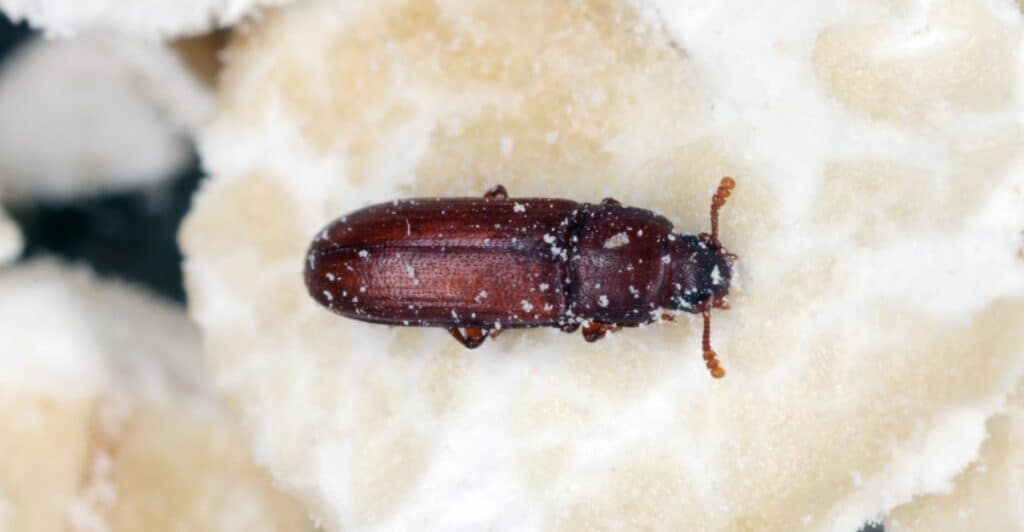Flour Beetle
Flour beetles are adapted to survive in very dry environments.
Advertisement
Flour Beetle Scientific Classification
Read our Complete Guide to Classification of Animals.
Flour Beetle Conservation Status
Flour Beetle Locations

Flour Beetle Facts
- Name Of Young
- mealworms
- Group Behavior
- Largely solitary
- Infestation
- Fun Fact
- Flour beetles are adapted to survive in very dry environments.
- Estimated Population Size
- Found in silos, warehouses, food storage facilties, pantries and cupboards
- Biggest Threat
- Birds, small rodents, lizards, and frogs
- Most Distinctive Feature
- Flour beetles have flattened bodies
- Habitat
- Found in silos, warehouses, food storage facilties, pantries and cupboards
- Predators
- Birds, small rodents, lizards, and frogs.
- Diet
- Herbivore
- Favorite Food
- cereals and other stored grain products
- Common Name
- flour beetles
- Special Features
- They can survive harsh conditions including high raditation environments
- Location
- Worldwide
- Nesting Location
- in stored food products and packaged foods
View all of the Flour Beetle images!
Flour beetles are adapted to survive in very dry environments.
Summary
Flour beetles are darkling beetles in the genera Tribolium or Tenebrio. These beetles are well-known pests of stored cereals such as wheat and other grains. The two most common types are; the confused flour beetles and red flour beetles. Although they’re very prolific pests of stored grain products, these beetles are scavengers. They only feed on grains that other pests have damaged. Scientists often use these beetles as laboratory animals because they are easy to keep.
Species, Types, and Scientific Name
The name Flour beetles apply to insects in the genera Tribolium or Tenebrio. Both genera of insects belong to the family Tenebrionidae, commonly known as darkling beetles. There are more than 20,000 species of darkling beetles. Insects in this family tend to seek out dark places and are more active at night than during the day.
The confused flour beetle (Tribolium confusum) and the red flour beetle (Tribolium castaneum) are two of the most common varieties. Other well-known species include:
- Aphanotus brevicornis – North American flour beetle
- Tribolium destructor – destructive flour beetle
- Tenebrio molitor – yellow mealworm beetle
- Tenebrio obscurus – dark mealworm beetle
They are found worldwide. They’re considered major pests in the agricultural industry that mainly attack stored food products. Their success as a group is mainly a result of their ability to survive in harsh environments. They’re highly resistant to insecticides, can survive in extremely dry conditions, and are even more resistant to radiation than cockroaches.
Appearance: How to Identify Flour Beetle

The name Flour beetles apply to insects in the genera Tribolium or Tenebrio.
©iStock.com/Tomasz Klejdysz
Many species of this beetle look quite identical. In fact, the confused flour beetle got its name because it is often “confused” with the red variety. They are typically small, usually around 3 – 6 mm (1/8 – 1/4 inch) in length. Most species are reddish brown. However, the less common Tribolium destructor is typically darker in appearance.
One way to distinguish between the different species is the shape of their antenna. The confused flour beetle has an antenna with four clubs, and that tends to grow increasingly in size. The antenna of the red flour beetle has only three clubs. The latter can fly short distances, while confused flour beetles cannot fly. Like other darkling bugs, the bodies of flour beetles are flattened. This adaptation makes it easier for them to crawl into tiny crevices. The larvae of all species look quite similar. Larvae. They’re typically white or yellowish, with slender and cylindrical bodies.
Habitat: Where to find flour beetles
Flour beetles are found worldwide as pests of stored food products. They infest grain-based products, and they’re the most common beetles in stored food products. You may find them in silos, food warehouses, museums, manufacturing facilities, and grocery stores. They can also be found in homes in pantries and food cabinets. Their flattened body makes it easier for them to get into tight crevices and thrive in dark corners.
Diet: What do flour beetles eat?
Both the adult and larvae forms of flour beetles feed primarily on stored food products. However, they can feed on both milled and packed products. They have chewing mouthparts and can eat flour, cereals, and other products such as dried beans, peppers, fruits, shelled nuts, peas, and chocolate. They may even get into museum specimens and have been found in some drugs.
Their larvae cannot penetrate whole and undamaged grain, so they mostly target whole grains damaged by other pests or already processed into flour. In addition, their feeding activities cause damage to food because it changes the flavor of the products they infest. They also leave their fecal pellets, dead bodies, and foul-smelling secretions in infested products.
What Eats Flour Beetles?
Because these beetles are more commonly found indoors, they’re not typically affected by predators. In theory, any insectivorous animal can feed on these tiny bugs. This includes birds, small rodents, lizards, and frogs. They do not have any natural defenses, and most species cannot fly.
Prevention: How to Get Rid of Flour Beetles
To control pantry pests like this, the first step is to identify the source of the infestation and remove any infested items. However, identifying all infested products is usually difficult. You should look closely at the oldest products on the shelf as they’re more likely to be the source of the infestation. Next, check the container for signs of damage. Generally, you should use or remove dried food products within 2 to 4 months of their purchase. You should also store food products in airtight containers.
Once you identify infested products, you should discard them right away. Maintaining good sanitation can help prevent infestations. Always vacuum pantry areas periodically. These beetles cannot survive temperature extremes, so heat or cold treatment can help eliminate this pest. Refrigerate for 7 to 14 days or heat in the oven at 130 degrees F for about 1 hour.
You can employ chemical control on rare occasions. The insecticide spray can be applied to possible hiding places such as crevices around pantries, cupboards, and drawers. Insecticide to use should be labeled for use in food- storage areas. Products like this contain active ingredients like pyrethrins, allethrin, and tetramethrin. They’re short-lived and relatively safe compared to regular insecticides.
Related Animals
View all 91 animals that start with FFlour Beetle FAQs (Frequently Asked Questions)
Are flour beetles dangerous?
Flour beetles are not dangerous in themselves. They cannot bite or sting humans and are not harmful if ingested. However, flour beetles can potentially contaminate food items. They can spread pathogens, and their presence allows the growth of molds that are potentially dangerous to people.
Why is it called confused flour beetle?
The confused flour beetle’s name is due to the confusion over its identity. This species of flour beetle is often confused with the red flour beetle. Both insects have the same appearance. The only difference between them is the number of segments on their antennae.
What is the life cycle of a flour beetle?
Flour beetles have a lifespan of 1-2 years. Adult females lay about 200 to 500 eggs in dried food products. The eggs hatch between 5-12 days, and larvae mature into adults within 30 to 120 days, depending on the temperature. The duration of the life cycle varies from one specie to the other.
Thank you for reading! Have some feedback for us? Contact the AZ Animals editorial team.
Sources
- Wikipedia, Available here: https://en.wikipedia.org/wiki/Confused_flour_beetle
- Nature.com / Michael D. Pointer, Matthew Gage, Lewis Spurgin, Available here: https://www.nature.com/articles/s41437-021-00420-1
- Wikipedia, Available here: https://en.wikipedia.org/wiki/Red_flour_beetle
- Texas A&M Extension / Mike Merchant, Bradleigh S. Vinson, Wizzie Brown, Available here: https://extensionentomology.tamu.edu/insects/flour-beetle/
















